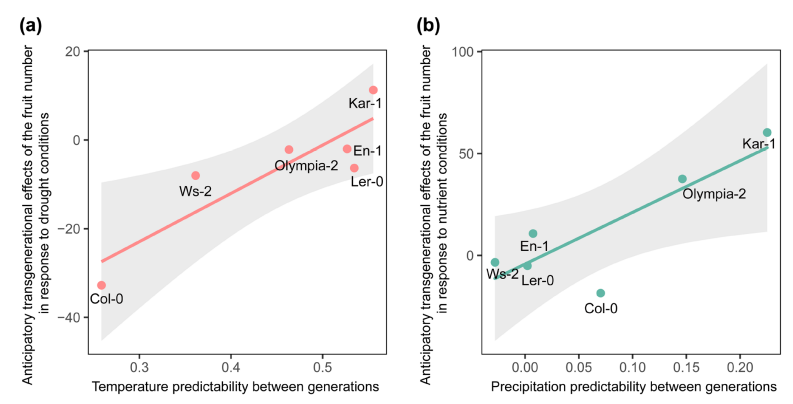Yin J.J., Lin X.H., Yao J., Li Q.Q. and Zhang Y.Y. 2022. Genotypic variation of transgenerational plasticity can be explained by environmental predictability at origins. Oikos 2022(5):e09006.
Transgenerational plasticity is the plastic response of offspring to ancestral environments. Theoretical studies and experimental evolution have demonstrated the importance of environmental predictability in driving the evolution of transgenerational plasticity. Nevertheless, the contribution of environmental predictability to the variation of transgenerational plasticity in nature remains unexplored. Here, we took advantage of the natural variation of Arabidopsis thaliana, and employed genotypes collected from different geographic locations to explore their transgenerational effects in response to drought and nutrient addition. We found that transgenerational plasticity depended on the offspring environment and the genotype. In particular, we found that genotypes with greater transgenerational plasticity in reproductive traits came from locations with greater temporal autocorrelation of annual temperature and precipitation. These results suggest that the evolutionary process shaping natural variation of transgenerational effect is not random, and the predictability of natural environments may contribute to the evolution of transgenerational effects. While the robustness of our study is limited by the number of genotypes analyzed, we hope this study provides an incentive to conduct a more comprehensive analysis towards understanding natural divergence of transgenerational plasticity.

This figure illustrates the significant results of weighted regressions in Table 2. The regression was applied to the fruit number, because it was the only trait shown a significant genotypic variation of transgenerational response (significant G × P.E. in Table 1). Regression results between climate predictability between generations (= temporal autocorrelation of annual mean temperature/precipitation) and genotype-specific anticipatory transgenerational plasticity of drought response (a) and nutrient response (b). Filled orange circles indicate genotype-specific anticipatory transgenerational plasticity of drought response. Filled green circles indicate genotype-specific anticipatory transgenerational plasticity of nutrient response. Grey belts show the 95% confidence interval of the regression analysis

